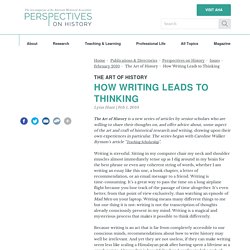

Motivational Interviewing Network of Trainers (MINT)
Singer 1972Famine fafluence morality essay about ethics vs other kinds of reasoning. How Writing Leads to Thinking. The Art of History is a new series of articles by senior scholars who are willing to share their thoughts on, and offer advice about, some aspect of the art and craft of historical research and writing, drawing upon their own experiences in particular.

The series began with Caroline Walker Bynum’s article "Teaching Scholarship". Writing is stressful. Sitting in my computer chair my neck and shoulder muscles almost immediately tense up as I dig around in my brain for the best phrase or even any coherent string of words, whether I am writing an essay like this one, a book chapter, a letter of recommendation, or an email message to a friend. Writing is time-consuming. It’s a great way to pass the time on a long airplane flight because you lose track of the passage of time altogether. Because writing is an act that is far from completely accessible to our conscious minds, recommendations about how to write history may well be irrelevant.
Poverty Simulations – CAP Services Inc. Teaching & Learning Taxonomies. Voki - Home. OER resources - check these out. 6 Must-Have Creation Tools for the BYOD Classroom. Providing opportunities for students to make and create is essential in 21st-century classrooms.

Children of all ages should experience the joy of seeing their work shared and celebrated. Classrooms with access to a variety of different tools have plenty of tech tool options. Are you a BYOD classroom? BYOD (bring your own device) is the term for schools that allow students to use a personal device as a learning tool. Some BYOD schools have clear policies for how devices must be used in a classroom. The following list is designed as a starter guide for teachers looking to turn their students into creators. After you've picked a favorite, play around with it -- just for fun. So let's dive into my list of those must-have creation tools! Seesaw At ISTE earlier this year, I had the chance to connect with the folks at Seesaw as well as meet several Seesaw Ambassadors. Adobe Spark Adobe Spark is really a collection of three creation tools.
EduBuncee Drawp for School KidBlog Google Drive. Interesting Ways – The Curious Creative.
Webinar and video conference tools. Problem and Project Based Learning. Group Work. Strategies for effective group work in the Online Class. This is the second post in a three part series on group work in online learning communities.

Post one, featured why we need group work in online learning, and post three will be on how to evaluate group work in online assignments. Quick recap – why oh why do we need to create opportunities for collaboration and structured learning in an online class? Because… Collaboration is the future—collaborative skills are essential skills for the 21st century.Working with others builds upon existing knowledge.
Great ideas were not created in vacuum —post one includes an excellent video about. Groups—my Dual Viewpoint I’ve experienced group work from the inside and out. Concurrently, I’ve worked with groups on the outside, working with professors extensively to create assignments and collaborative activities for students in several online classes at my work place. Create a student introductory forum in the first week, or even a few days before the course start date. Like this: Like Loading... Learner profiles and addressing behavior issues in an online environment.
Problem Based Learning Review Azer. Vanderbilt University. Classroom Assessment Techniques (CATs) Print Version What Are CATs?

Classroom Assessment Techniques (CATs) are generally simple, non-graded, anonymous, in-class activities designed to give you and your students useful feedback on the teaching-learning process as it is happening. Examples of CATs include the following. The Background Knowledge Probe is a short, simple questionnaire given to students at the start of a course, or before the introduction of a new unit, lesson or topic. It is designed to uncover students’ pre-conceptions.The Minute Paper tests how students are gaining knowledge, or not. Why Should I Use CATs? CATs can be used to improve the teaching and learning that occurs in a class. How Should I Use CATs? Results from CATs can guide teachers in fine-tuning their teaching strategies to better meet student needs.
Where Can I Find More CATs? The standard references on CATs is Classroom Assessment Techniques: A Handbook for College Teachers, 2nd edition, by Thomas A. Should You Change Answers on Multiple-Choice Tests, or "Stick With Your Gut?" Should you change your answers on test questions?

I’m going to spoil it right up front: In general, the answer is yes. Research has been conducted multiple times over the course of the last seventy years on this problem, and the results are clear. Most answer changes are from wrong to right, which means that most people who do choose to change answers will actually improve their test scores. This fact goes completely against what people think, though. Scholarship of teaching presentation gurung Sept 15 2017.